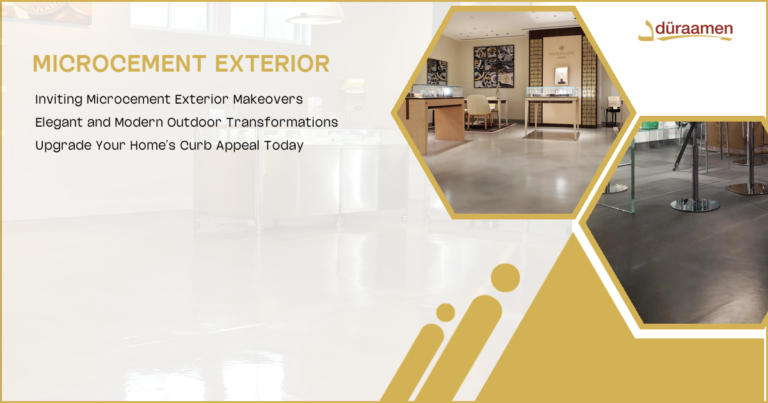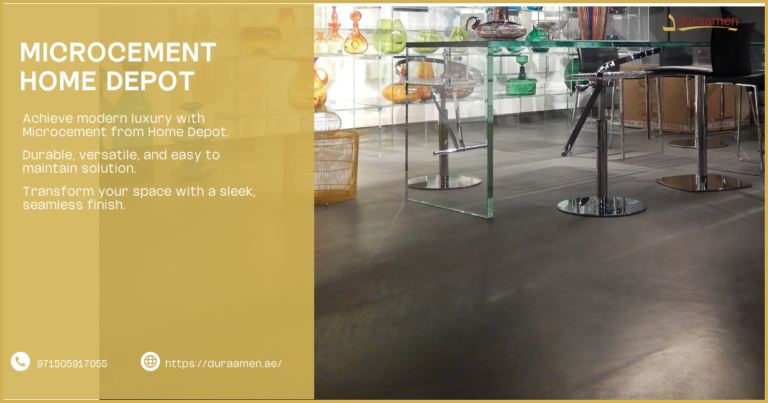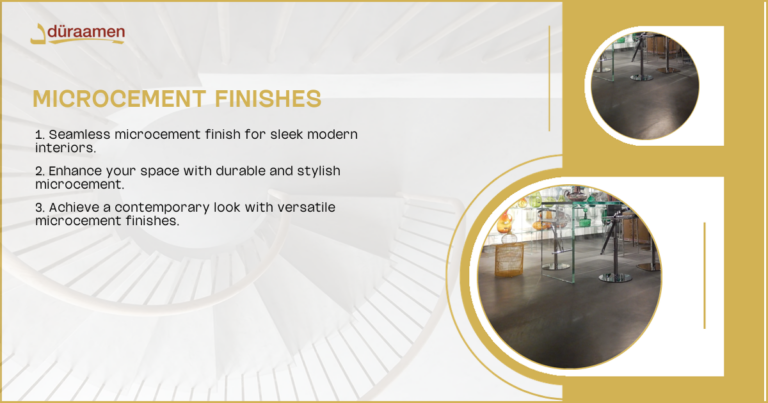Microcement vs Tadelakt
When embarking on a new construction or renovation project, the choice of materials can significantly impact the final outcome. Two popular plaster options that stand out for their unique qualities are Microcement and Tadelakt. Understanding their characteristics and applications is crucial for making an informed decision that aligns with your project’s aesthetic and functional requirements.
Microcement:Definition and Composition
Microcement is a polymer-modified cement-based coating that can be applied to a variety of surfaces. It is known for its flexibility and thin application.
Dubai’S Microcement is a special type of coating used on floors and walls to make them strong and beautiful. it’s like a super-strong paint that makes buildings in dubai look shiny and new.
- Composition: Cement, polymers, aggregates, and pigments
- Flexibility: Reduces the risk of cracking
- Thin application: Can be applied over existing surfaces
Tadelakt:Definition and Composition
Tadelakt is a traditional Moroccan lime plaster known for its waterproof and decorative properties.
- Composition: Lime, water, and color pigments
- Origin: Moroccan technique for waterproofing
- Natural look: Provides a unique, organic finish
Historical Origins and Traditional Uses
Microcement originated in Europe as an industrial material, while Tadelakt has been used for centuries in Moroccan architecture.
- Microcement: Modern, industrial applications
- Tadelakt: Traditional Moroccan baths and walls
Comparing Characteristics: Tadelakt and Microcement
Aesthetic Differences: Texture and Finish
The aesthetic appeal of Microcement and Tadelakt is distinct, with each offering unique textures and finishes.
- Microcement: Smooth, contemporary look
- Tadelakt: Warm, tactile feel with subtle variations
Application Techniques for Tadelakt and Microcement
The application of these materials requires specific techniques and skills.
- Microcement: Layered with a trowel or spatula
- Tadelakt: Polished with a stone and treated with soap for waterproofing
Durability and Maintenance Considerations
Both materials are durable, but their maintenance needs differ.
- Microcement: Generally low maintenance
- Tadelakt: Requires periodic re-soaping to maintain waterproofing
Advantages of Microcement
Versatility in Application
Microcement can be applied to floors, walls, and even furniture, making it a versatile choice for various design projects.
- Adheres to most surfaces
- Suitable for both indoor and outdoor use
- Can be used to cover tiles, wood, and concrete
Range of Colors and Effects
With a wide range of pigments available, Microcement offers extensive customization options.
- Customizable colors
- Metallic and other special effects
Seamless Coating and High Adhesion
Microcement provides a seamless surface that is both aesthetically pleasing and practical.
- No joints or seams
- Strong adhesion to substrates
Advantages of Tadelakt
Ecological and Natural Composition
Tadelakt is an eco-friendly option that appeals to those seeking natural building materials.
- Free from synthetic additives
- Breathable, regulating indoor humidity
Resistance to Humidity and Durability
Tadelakt’s waterproof nature makes it ideal for wet areas.
- Naturally water-resistant
- Long-lasting with proper maintenance
Unique Finishes and Artisan Appeal
The hand-applied nature of Tadelakt gives it an artisanal charm.
- Each application is unique
- Artisan-crafted surfaces
Where to Use Tadelakt and Microcement? 
Tadelakt in Bathrooms: Benefits and Aesthetic Appeal
Tadelakt is particularly suited for bathrooms due to its water-resistant properties.
- Ideal for showers and sinks
- Creates a spa-like atmosphere
- Microcement for Floors and Walls: When to Choose It
Microcement is a great choice for creating a modern, industrial look on floors and walls.
- Durable for high-traffic areas
- Versatile for various design styles
Installation Process: Tadelakt vs Microcement
Preparing the Surface for Application
Both materials require a stable and clean surface for application.
- Removal of loose particles and debris
- Ensuring the surface is dry and absorbent
Priming and Layering Techniques
Proper priming and layering are essential for a successful application.
- Microcement: Use of a specific primer for adhesion
- Tadelakt: Application of several layers with specific tools
Sealing and Finishing Touches
Sealing is crucial for both materials to achieve the desired finish and durability.
- Microcement: Sealed with a polyurethane or epoxy sealant
- Tadelakt: Treated with olive soap for a waterproof finish
Cost Considerations: Tadelakt vs Microcement
Calculating the Cost per Square Meter
The cost of both materials can vary based on several factors.
- Initial material costs
- Labor intensity of the application
Factors Influencing the Price: Labor, Materials, and Finish
The complexity of the project and the desired finish can affect the overall cost.
- Skill level of the installer
- Quality of the materials used
Outdoor Use and Durability
Suitability of Tadelakt and Microcement for Exterior Applications
Both materials can be used outdoors, but their suitability varies depending on the climate and exposure.
- Microcement: Resistant to UV and weather conditions
- Tadelakt: Best in drier climates due to its natural composition
Weather Resistance and Longevity
The longevity of the finish is influenced by how well it can withstand weather conditions.
- Microcement: Generally more resistant to freezing and thawing
- Tadelakt: May require more maintenance in harsh weather
Customization and Design Flexibility 
Achieving Custom Colors and Textures
Both materials offer a range of customization options to match any design palette.
- Microcement: Wide variety of colors and textures
- Tadelakt: Natural pigments for authentic tones
Creative Possibilities with Tadelakt and Microcement
The versatility of these materials allows for creative design solutions. Premium microcement selections offer top-quality options for smooth and durable surfaces in homes and buildings These high-end choices provide a sleek modern look that is both stylish and long-lasting
- Microcement: Can mimic other materials like concrete or stone
- Tadelakt: Traditional Moroccan designs and finishes
Maintenance and Care
Cleaning and Upkeep of Tadelakt and Microcement Surfaces
Regular maintenance ensures the longevity of the surfaces.
- Microcement: Easy to clean with neutral pH cleaners
- Tadelakt: Periodic re-soaping to maintain water resistance
Repair and Renovation Tips
Both materials can be repaired if damaged, but the methods differ. Proper Microcement Stairs Coverage is a method that makes your stairs strong and beautiful. It’s like a special coat for your stairs to protect them from damage. “Procedure for Microcement Usage” is a step-by-step guide on how to properly use microcement for construction. It’s like a recipe for making a strong, smooth surface with this special type of cement.
“Microcement Waterproofing Capabilities” means that microcement can stop water from getting through because it’s waterproof. It’s like a raincoat for buildings, keeping them dry and safe. Microcement Ingredients are the special materials used to make microcement, a type of strong and smooth flooring. These ingredients are mixed together to create a durable surface that can be used in homes and buildings.
Wall microcement finish is a smooth, durable coating that makes walls look stylish and modern, perfect for any room in your home.
- Microcement: Patching with the same material
- Tadelakt: May require reapplication of the finish layer
FAQs:
Can Tadelakt and Microcement be used interchangeably?
While both can be used in similar applications, their unique properties make them better suited for specific environments and aesthetics.
How do the application processes differ?
Microcement is applied in thin layers and sealed with a synthetic sealant, while Tadelakt is applied in thicker layers and treated with soap for waterproofing.
What are the best environments for each material? Microcement is versatile for both indoor and outdoor environments, while Tadelakt is ideal for indoor wet areas like bathrooms. Microcement bathroom budget means how much money you need to make your bathroom look nice with a special smooth coating called microcement Microcement microtopping assessment checks how well thin layers of special cement cover floors and walls It looks at things like smoothness durability and how nice it looks
Microcement expense reasons Microcement can be costly due to the special materials needed and the skilled labor required for proper installation The unique finish and durability of microcement also contribute to its higher price compared to some other flooring options
Can you mix colors to create custom shades?
Yes, both materials can be tinted with pigments to achieve custom colors.
Are there specific primers recommended for each material?
Yes, each material requires a specific primer to ensure proper adhesion to the substrate.
Conclusion
Choosing between Microcement and Tadelakt depends on the specific requirements of your project, including the desired aesthetic, application environment, and maintenance considerations. Both materials offer unique advantages and can significantly enhance the look and feel of a space.





